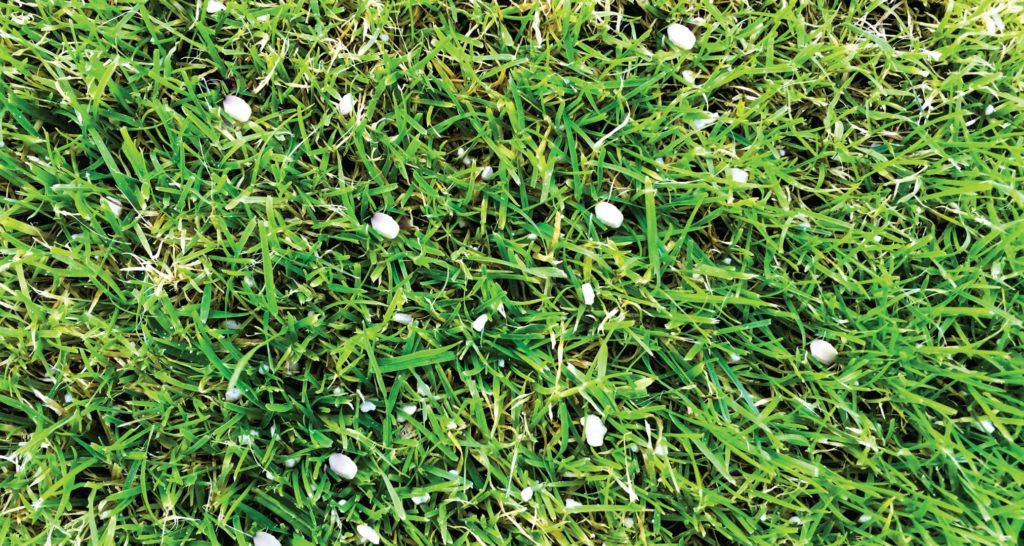Lawn Lime Treatment: Everything You Need to Know about Lime Treatment
An often-overlooked lawn care treatment is a lime application — a lawn care treatment that helps balance your soil’s pH levels. Over time, your soil can become acidic, which is not optimal for healthy grass to grow in specific environments. But, how can you tell if your lawn is acidic and needs a lawn lime treatment?
Overview
What Is Lime?
The lime used for lawns is a natural sedimentary rock that is dug from quarries or underground mines. This naturally-occurring type of rock contains essential minerals and high levels of calcium and magnesium carbonate. Although lime includes calcium and magnesium, which are necessary nutrients for healthy plant growth, adding lime is not a fertilizer substitute.
What Are The Benefits of Lawn Lime Treatment?
Once lime is prepared for agricultural purposes, offers many benefits, such as:
- Neutralizes pH levels
- Increases the availability of nutrients in the soil for plants
- Reduces soil toxicity levels
- Promotes soil microbe activity
- Improves soil structure
Why Is Supporting a Balanced Soil pH Level Important?
What Is pH?
pH (abbreviation for potential hydrogen) is a scale representing the relative acidity or alkalinity in your soil.
A pH scale ranges from 1.0 up to 14.0, with 7.0 being neutral. If the soil pH is lower than 7.0, your lawn has more acidity. If the soil pH is higher than 7.0, your lawn has more alkalinity.
What Does pH Do to Your Lawn?
It is essential to understand your soil pH levels because it can significantly affect which nutrients are accessible to your plants. When the pH is too high or low, your lawn will lose micronutrients that keep it healthy and thriving.
How Do I Test My Soil’s pH Levels?
Measuring your soil’s pH levels can be done with a soil testing kit or a meter purchased at any home improvement retailer, like Lowe’s or Home Depot.
Soil testing kits are sufficient if you have a small yard and do not plan on testing very often. Each soil testing kit can do multiple tests – usually twelve to fifteen times – and cost $10 to $35, depending on the number of tests available in the pack and if the kit checks for additional soil nutrients. The soil testing strips provide you with your soil’s pH by producing several different colors, which you will need to analyze. An electric soil pH meter can be used indefinitely and provide you with a quick, accurate reading. These electric meters generally cost $50 to $70.
No matter what you use, it is essential to take three to four samples of the soil you are testing by mixing the soil with water. It is necessary to use water that is neutral-pH, or it will alter your results. Using distilled water for soil testing is recommended since it tends to be neutral. If you are unsure, test the water’s pH. Keep in mind that soil pH does not stay the same and will change over the year, especially when soil temperature changes. Your soil’s pH levels will also be different throughout your yard.
How Do You Adjust Your pH Levels?
For pH Levels Below 6.0 (Acidic Soil)
To increase soil pH levels, you will need to add lime to your soil.
For pH Levels Above 6.0 (Alkaline Soil)
To lower soil pH levels, you will need to add a type of soil additives such as ground sulfur, calcium sulfate, iron sulfate, aluminum sulfate, or garden gypsum.
How Will I Know If Lime Is a Good Option For My Lawn?

When your soil becomes too acidic, grasses struggle to grow and stay healthy, while plants and weeds flourish in acidic soil and take over your lawn. Lawn moss signifies that your soil pH has become too low for strong, healthy grass growth. Another warning sign includes increases in common lawn weeds, diseases, and insect pests.
You will know that something is not right with your lawn if it still does not look healthy, even if you are:
- Watering your lawn frequently
- Frequently mowing and mowing at the correct height for your grass
- Recycling grass clippings back onto the lawn
- Fertilizing your lawn as needed and seeing little results
Tee Time Tip: Again, a soil test is the best way to find out if your lawn soil is acidic and needs liming. Make sure to rule out other common lawn problems such as the ones listed above
What Season Is Best To Apply Lime?
You can apply lime anytime throughout the year, but fall in the most beneficial time. Using lime in the fall allows the lime to break down over the winter months and get the soil better for springtime growth. After applying lime, make sure to water the lawn to allow the lime to contact the soil.
How Often Should I Apply Lawn Lime Treatment?
You can apply lime to your lawn yearly. Make sure only to use lime if a soil test determines that your lawn soil is acidic. Unnecessary liming can lead to alkaline soil.
How Quickly Will I See Results After Applying Lime?
How quickly the lime begins to work depends upon how low your lawn’s pH level was. It is also important to know that it takes a few months to start seeing a difference. Be patient and let the applied lime work its magic.
Can You Over-Lime Your Lawn?
When there is too much lime applied, the soil will become alkaline.
DIY Lawn Lime Treatment:
Where Can I Buy Lime?
Lime can be purchased at any home garden retailer such as Lowe’s or Home Depot.
How And When To Apply Lime
Once you have determined that your soil’s pH level is acidic (lower than seven on the scale), it is time to apply a lime application. Consider aerating your lawn before liming to ensure the lime reaches deep into the soil and produces the best results!
Pelletized lime can be purchased at any home improvement store such as Lowe’s or Home Depot and easily applied. The pellet version of the ground limestone is more efficient than powder versions because it’s less likely to blow away in the wind and will stay put once it reaches the soil.
Plan accordingly based on the size of your lawn to purchase the correct amount of lime.
Lime will work best when it is evenly distributed on the lawn. Use a drop or rotary spreader to blanket the grass with a lime layer — never use your hands because it can irritate the skin. If you are careless while applying lime, it can lead to poor results, including raising pH levels in areas with higher amounts of lime and patchy regions that the lime did not reach or neutralize pH levels.
DO NOT apply limestone during frosty weather or on a wet or wilted lawn.
Lawn Lime Treatment Lawn Care Professional or DIY?

If you plan on the DIY route, remember that it can be challenging to apply lime evenly. Uneven application is not good for your yard, as it leaves certain areas too acidic while others may become too alkaline. Either condition can result in poor growth. Also, do not wait too long in the season as lime needs to penetrate through several soil inches. You will want to get it in sooner than later to ensure you grow healthier grass in the following season.
Limestone can be a tricky business. It is essential to know that you are laying the proper amount, at the right time, in the right places. One of the benefits of working with a lawn care professional, like Tee Time, is that they have the tools and knowledge required about your lawn’s soil pH levels and applying like to your lawn.
If your lawn’s giving you lemons, think about lime! Call the pros at Tee Time Lawn Care or use the nearby quote form.





